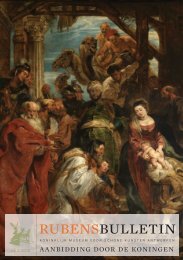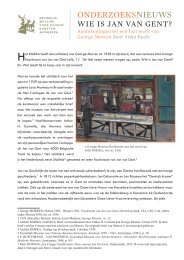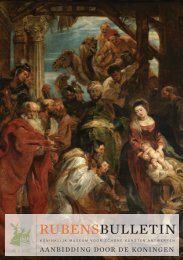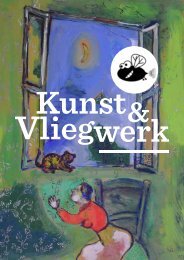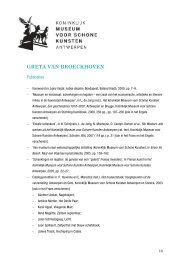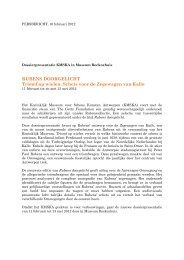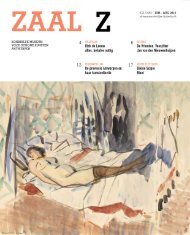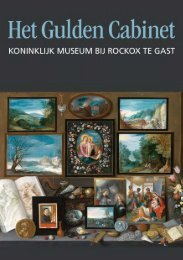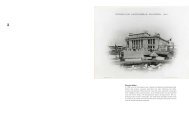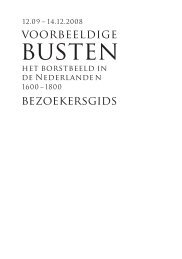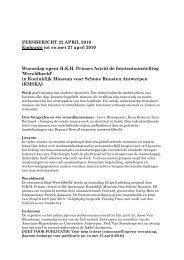III. Painting Technique and Restoration (PDF, 5,21 MB) - Koninklijk ...
III. Painting Technique and Restoration (PDF, 5,21 MB) - Koninklijk ...
III. Painting Technique and Restoration (PDF, 5,21 MB) - Koninklijk ...
You also want an ePaper? Increase the reach of your titles
YUMPU automatically turns print PDFs into web optimized ePapers that Google loves.
BULLETIN<br />
BULLETIN<br />
d. The imprimatura<br />
A pale grey stripey imprimatura is present but not easily detected. Stripey<br />
imprimatura is characteristic of Rubens panel paintings but it is most<br />
commonly seen in his sketches on panel, such as the recently restored<br />
Triumphal Chariot of Kalloo (KMSKA, inv. no 318),<br />
where the imprimatura is ochre rather than grey.<br />
It is often less apparent in his finished paintings, as<br />
is the case here. It can be seen, however, in the gap<br />
between the painted contours of the wooden post<br />
<strong>and</strong> the sky <strong>and</strong> through the transparent brown<br />
paint of the post (ill. 6). The imprimatura can be<br />
seen more clearly with infrared photography (ill.<br />
7) where it appears to have<br />
been roughly applied with<br />
a wide bristle brush in<br />
horizontal <strong>and</strong> diagonal<br />
directions (2.), changing<br />
to a vertical direction<br />
along the vertical edges.<br />
Ill.6 The grey stripey imprimatura<br />
can be seen in the gap in the paint<br />
between the post <strong>and</strong> the sky.<br />
Rubbed away the overlying paint<br />
layers.<br />
The stripey imprimatura may have acted as an<br />
isolation layer preventing the oil of the paint layer<br />
from sinking into the porous white ground. It<br />
was also a device to give a tonality to the ground<br />
without losing its luminosity.<br />
Ill. 7 The grey stripey imprimatura<br />
is visible under the transparent paint<br />
layer of the tree <strong>and</strong> the wooden post.<br />
e. The underdrawing<br />
No underdrawing was visible or detected by infra-red photography. It is,<br />
in any case, unusual to find underdrawing in Rubens’s finished paintings,<br />
although more common in his sketches. An example, however, can be found<br />
in The Farm at Laeken, (London, The Royal Collection), where “lines of<br />
underdrawing are visible in the arm <strong>and</strong> face of the st<strong>and</strong>ing woman in the<br />
centre” 8<br />
f. The paint layer<br />
Pigments<br />
Analysis: a number of inorganic pigments have been identified by using<br />
PXRF, a non-destructive method of analysis. 9 Organic pigments frequently<br />
used by Rubens, such as red <strong>and</strong> yellow organic glazes, indigo, Cassel earth<br />
<strong>and</strong> bitumen, cannot be identified by this method of analysis.<br />
The following pigments were identified: white lead was identified in the<br />
29 places that were analysed; sienna or possibly umber in the browns with<br />
occasional traces of vermilion; vermilion probably in combination with red<br />
earth for the reds; in the yellow highlights of the hay, lead-tin yellow with<br />
probably a yellow earth. The greens were composed of a mixture of yellow,<br />
probably lead tin yellow <strong>and</strong> a copper containing pigment, such as azurite,<br />
or blue or green verditer. The blues used for clothing contained copper<br />
indicating the use of azurite or blue verditer. However the blue for the sky<br />
could be identified as either indigo or ultramarine / lapis lazuli. Very few<br />
samples were taken from the paint layer. Two samples were taken from<br />
the grey paint on the margin of the left edge. This was to identify the large<br />
white grains that occur throughout the paint layer but predominantly in<br />
the dark area of the roof, on the left side of the picture. Another sample was<br />
taken in the sky to identify the blue pigment that could not be determined<br />
by PXRF.<br />
The ubiquitous white granular pigment was identified as lead white. The<br />
sample taken to analyse the blue pigment in the sky can be seen in crosssection<br />
(ill.8) where ultramarine/<br />
lapis lazuli was identified. The<br />
under-lying grey layer contains<br />
chalk <strong>and</strong> lead white. Originally we<br />
believed it to be the ground layer<br />
but now see it as an intermediate<br />
layer <strong>and</strong> that the ground layer is<br />
missing. 10<br />
Ill.8. Cross-section, taken from the sky with part of a leaf.<br />
The blue pigment was identified as ultramarine / Lapis lazuli.<br />
(Photograph, Antwerp University).




